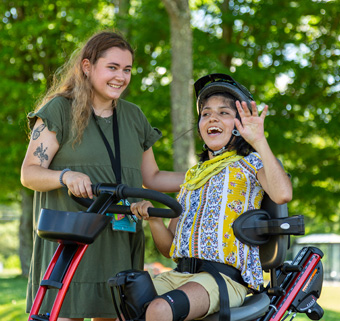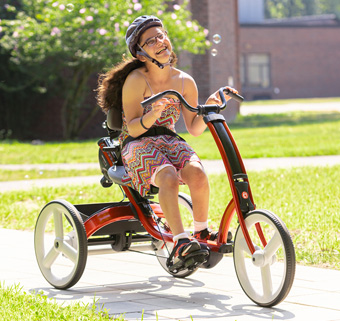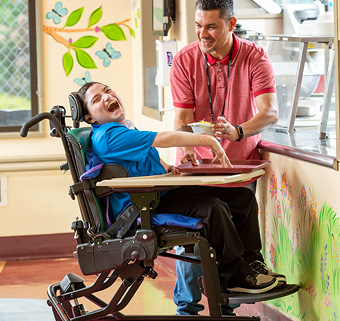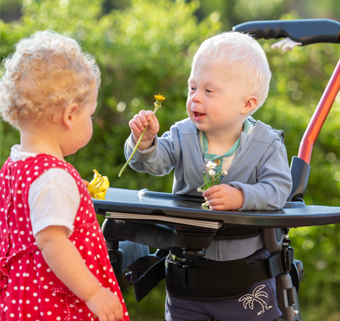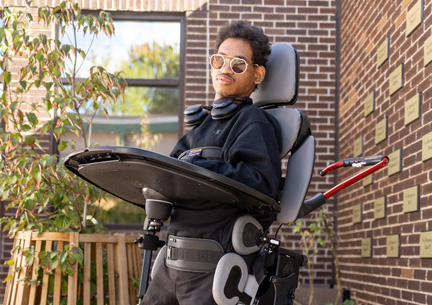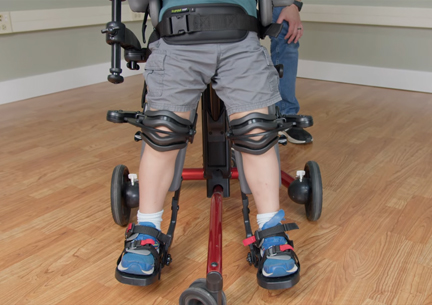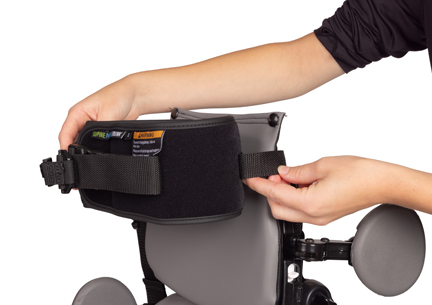Evidence Update: Shining a Spotlight on Supported Standing for Children and Young Adults with Non-Ambulatory CP
| February 2023 For children with non-ambulant cerebral palsy, supported standing has long been recognized as a beneficial intervention. Research to date shows supported standing positively affects hip stability, bone mineral density, range of motion, participation and overall quality of life. Therefore, adaptive standing is a mainstay in early intervention, postural management and physical activity for this population.
For children with non-ambulant cerebral palsy, supported standing has long been recognized as a beneficial intervention. Research to date shows supported standing positively affects hip stability, bone mineral density, range of motion, participation and overall quality of life. Therefore, adaptive standing is a mainstay in early intervention, postural management and physical activity for this population.
For children using wheeled mobility, supported standing addresses fitness, function and friendships, through providing an alternative upright position which relieves pressure from prolonged sitting, aids with contracture management and bone health and most importantly, allows a child to engage with their peers at eye level.
Although recognizing the clear benefits of standing for children with significant levels of disability, there are gaps in the evidence to adequately substantiate the intervention. For this reason, McLean, Paleg and Livingstone conducted a comprehensive synthesis of available evidence on standing to provide recommendations for clinical practice and future research. The study, “Supported-standing interventions for children and young adults with non-ambulant cerebral palsy: A scoping review,” describes the evidence, outcomes and lived experience of adaptive standing interventions in a population of children and young adults with cerebral palsy. Participants of the study were in GMFCS levels IV and V and aged 25 years or younger. The study’s findings were summarized across body functions and structures and activity outcomes, supplementary considerations and lived experience of supported standing.
Outcomes of Supported Standing
Body Functions and Structures and Activity
Because children with non-ambulant cerebral palsy are particularly predisposed to decreasing bone mineral density and osteoporosis as they grow older, the researchers indicate that using supported standing to increase bone mineral density, prevent fractures and subsequent disability is worthwhile. This intervention has particular impact when embedded into a child’s daily routine to improve function and participation.
Evidence also supports the use of adaptive standers to maintain postural alignment and prevent contractures. Not only does this reduce pain and deformity associated with asymmetries, but also helps the child to maintain the motion needed to actively assist in sit-to-stand transitions that allow for the benefits of weight-bearing and active muscle use. This purpose is more important than we might suppose, especially as it can contribute to independence in activities of daily living across an individual’s lifetime. For this reason, the researchers conclude that adaptive standing is an important part of 24-hour positioning initiatives that can further contribute to reducing spasticity and benefiting other functions of daily living.
A number of studies have additionally examined the benefits of supported standing in abduction for maintaining hip integrity in children with GMFCS levels lV and V. This is because in the growing child, weight bearing and physical activity are important contributors to hip alignment and stability. Although evidence continues to be inconclusive, the researchers note that clinical practice agrees with 10-15 degrees of abduction per side for at least 1 hour every day to reduce hip migration. Trends in the literature suggest that supported standing in abduction should be continued across the developmental years for the most benefit.
Supplementary Considerations for Supported Standing
Choosing the appropriate stander type (prone, supine or mobile) to meet the child’s particular standing goals is important when designing standing programs. For instance, if improving bone mineral density is a priority, research can guide us on the stander type, alignment and features for best outcomes.
Supported standing interventions additionally address sedentary behaviors in this population. Although guidelines suggest daily doses of moderate to vigorous aerobic physical activity for people with disabilities to maintain their health, this is mostly not feasible for children with non-ambulant cerebral palsy. Adaptive standing however, is an appropriate intervention that contributes to breaking up sedentary positions throughout the day to increase energy expenditure and encourage muscle activity. This is why we try to replace passive positioning with active sit-to-stand transitions and standing activities in daily routines.
The use of standers in early childhood is another area of intervention. Early childhood is a crucial stage of physical development and most children start pulling to stand between 8 and 11 months. The researchers note that this is the age when differences in muscle growth become apparent between children with cerebral palsy and those with typical development. Measures such as the Hammersmith Infant Neurological Exam (HINE) also provide early clinical indication which infants with cerebral palsy may not achieve independent walking. Providing comparative developmental experiences in standing and weight-bearing then, have the potential to maximize these key times of physical development.
With regard to adaptive standing dosing for children with cerebral palsy GMFCS levels IV and V, the literature informs us that 30-60 minutes 5-7 times per week is generally tolerated. Sixty minutes of standing may be best for contracture management while increased times of 60-120 minutes may have more impact on bone mineral density and hip stability.
Lived Experience of Supported Standing
The perspectives of the children actually using the standing devices are important in determining the effectiveness of the intervention along with the available evidence. Not surprisingly, research shows that parents, children and therapists firmly believe in the benefits of supported standing and its value beyond weight-bearing to improving bowel and bladder management, respiratory function and psychological status. Parents also generally have a good feel for stander alignment and how to position their child comfortably.
The researchers also indicate the importance of individualized assessment to best match the child’s needs with the appropriate device. Stander comfort and alignment are primary considerations while taking into account that stander availability, familiarity and funding may be strong influencers as well.
Importantly, providing children the choice of when and where to stand is key. Standing is motivating when incorporated into activities that a child wishes to do as part of their daily routine. Standing just for the sake of standing with no goal in mind loses its appeal quickly. Close teamwork between parents, therapists, school staff and the child can make these opportunities possible in the school and the home for best standing outcomes.
Future Recommendations
As is true across most pediatric interventions, further research is needed to substantiate the effectiveness of supported standing across different outcomes. However, by considering available evidence, clinical expertise and the child’s perspective, the researchers opened up a pathway for evidence-informed practice in regards to supported standing for children with non-ambulant cerebral palsy, and provide recommendations towards creating solid clinical guidelines in the future.
Overall, this scoping review provides a welcome and much needed contribution to supported standing intervention, showing clearly that adaptive standing programs are well tolerated and, if effectively incorporated into daily routines for improved participation, can contribute to overall physical health in children with cerebral palsy.
Reference:
McLean LJ, Paleg GS, Livingstone RW. Supported-standing interventions for children and young adults with non-ambulant cerebral palsy: A scoping review. Dev Med Child Neurol. 2022; 00:1-19. https://doi.org/10.1111/dmcn.15435
